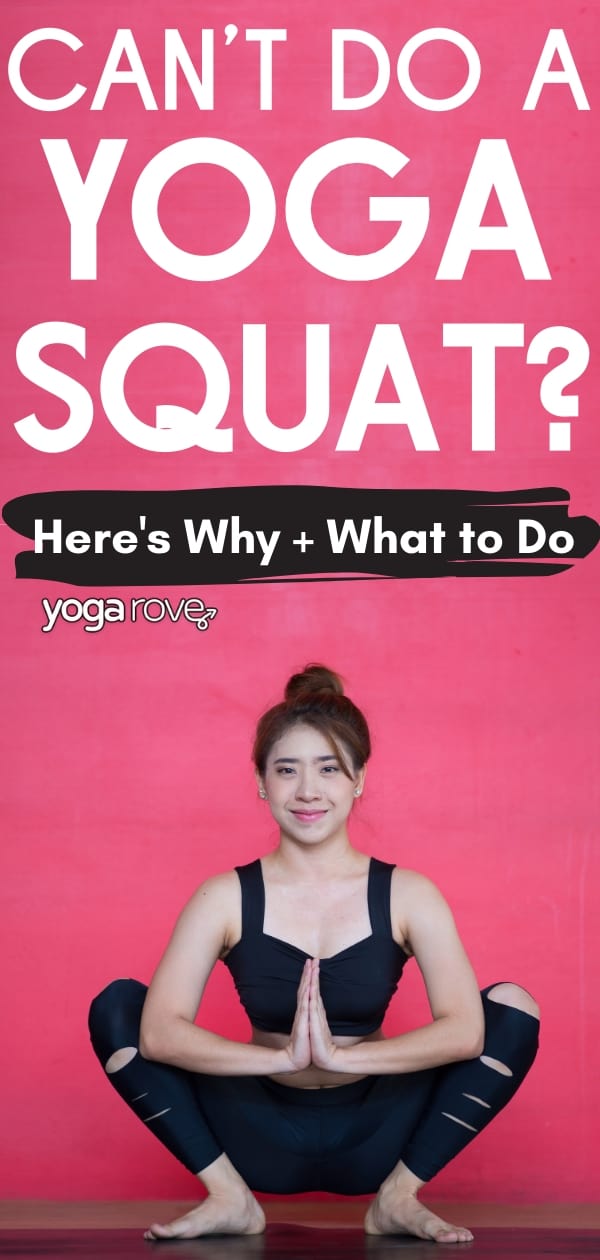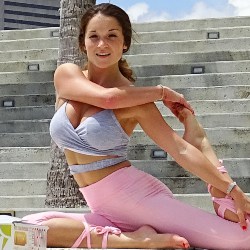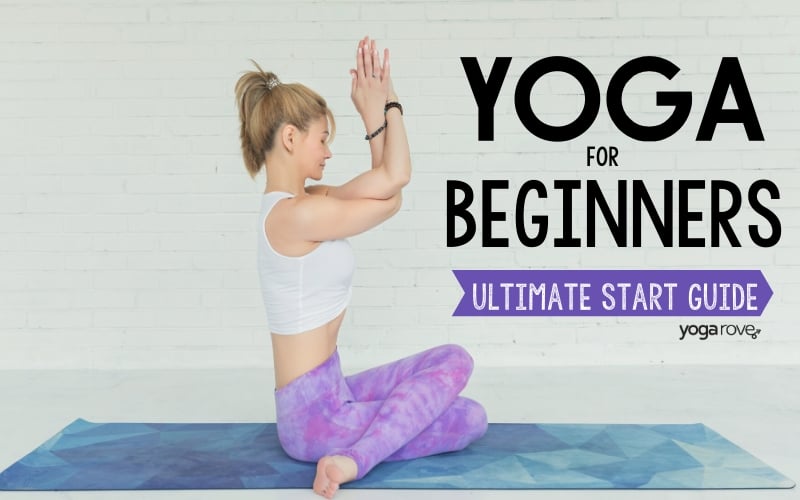This post may contain affiliate links. Please read our disclosure for more info.
Yoga Squat, Malasana, Garland, or Deep Squat- whichever name you want to call it- can be a challenging pose for beginners. I myself struggled with this pose in the beginning, as my feet would always seem to rise off the ground, and I could never get comfortable!

Wondering why you can’t do Yoga Squat? It usually comes down to either not placing your feet and ankles in the correct position for your body (after all, all poses are built from the ground up), or as a result of inflexibility in your hip flexors, knee joints, or even calves and Achilles tendons. Not to worry – there are easy fixes for all of these.
Keep in mind that there are a lot of joints and muscles working in Yogi Squat, so if you are compensating for a lack of strength or flexibility in one muscle or joint, another muscle or joint will often pick up the slack of the weak one – which can usually cause more harm than good. That is why you should read through the following specificities of the posture to achieve a comfortable Yoga Squat.
6 Reasons Why You Can’t Do a Yoga Squat
1. Your foot placement isn’t right for your body
No matter what pose you’re in, it always starts from the bottom up with your feet.
When you enter Deep Squat, do you find that your heels lift off the mat? If so, your feet may actually be too wide apart.
Sometimes practitioners think that having the feet closer in is a sign of being “more advanced,” but that’s simply not the case. Some people’s physical bone structure of their hips is wider than other people’s, so of course their stance must be wider!
Generally speaking, those with a wider build and wider hips will need their feet to be mat’s width distance apart. It’s a good rule of thumb to start by entering the pose with the feet about 2-3” wider on each side than hip’s width, lower into squat, and if heels lift or are uncomfortable, place the palms on the mat to scootch the heels outward.
Your feet should turn slightly outward, at about a 60-45 degree angle (again, entirely dependent on your bone structure), but no matter where they are, make sure that your knees are tracking directly outward over the 2nd or 3rd toe.
What if My Heels are Still Lifting in Yogi’s Squat, Even Though I’ve Widened my Foot Position?
If you’ve tried widening your stance and you still can’t get your heels to the floor, that’s totally fine – it could simply be that the tendons and muscles in your calves and ankles are not flexible enough – especially common in people who wear high heels all day.
This flexibility will come with practice, but to make the position comfortable for that practice (because often if something is uncomfortable, we like to avoid it), you can fold your mat up underneath your heels, or roll a blanket or towel and place it under the heels. Allow your heels to meet the mat or towel – don’t hold tension in the calves.
2. Your knees are twisting as a result of incorrect alignment
No matter how wide your feet are, the knees in your deep squat should be tracking directly over the 2nd or 3rd toe from the big toe.
How to fix it: If your knees are shifting inward, it’s a sign you need to bring your heels a little wider (or your toes a little closer) – try just an inch to start with – until the knees track directly over the middle of the foot.
Think of your toes inching closer to a 90-degree angle than a 180-degree angle. If your knees are shifting outward in your garland pose, simply do the opposite.
What about knee joint pain in my deep yoga squat?
If you’ve played with foot position/width and are still uncomfortable, the tendons and ligaments in your knees may not be flexible enough to support the posture yet.
To fix this, you can roll a towel, blanket, or even use a regular ol’ pillow, and place it behind your knee joint, so that when you squat down, the lower back of your thigh and the top of your calf keep the roll in place, and provide a little padding and support for the knees in posture.
3. You’re not lifting the upper body out of the lower body
Though deep yoga squat is an intense hip-opening posture, you must keep your core and trunk engaged in order to keep the spine long and chest lifted.
A common term in dance and yoga is “root to rise” – by establishing a super-strong base by rooting your lower body into the floor, you are able to lift the rest of the body to rise upward, which alleviates the lower body from bearing the weight of the upper body.
When you engage your pelvic floor, abdominals, and trunk (back) muscles, you use the upper body’s strength to sustain the itself, instead of “dumping” the upper body’s weight into the lower body. I mean, really, you’ve got enough going on in the hips in deep squat – you don’t need to add more!
How to engage the upper body to make deep yogi’s squat easier:
- Use your hands: Bring your hands to heart’s center and press the palms together, as you place your elbows inside the knees and press outward.
- Use your elbows: Press the elbows/triceps into your knees to keep the knees tracking over the middle of each foot.
- Relax the shoulders: Draw the shoulders away from the ears and down the back, allowing the neck to lengthen. Note that the crown of your head should not be tracking straight to the ceiling, since your torso is at an angle due. Your head, neck, and entire spine should be in one continuous line.
- Work the abs: Engage the core and pelvic floor so that the tailbone is slightly tucked – you don’t want your booty sticking out! Allowing this to happen only stresses the lower back.
4. The strength or flexibility simply isn’t there yet (and that’s totally ok!)
Your calves and shins may not be strong enough to hold this posture yet.
Your ankle or knee tendons may not be flexible enough to hold this posture yet.
Your pelvic floor or abdominals may not be strong enough to lift your upper body to keep you from losing your balance yet.
All of this is ok, and there’s an easy solution! The trusty yoga block, and a little bit of work:
For flexibility: Sit on a yoga block to establish your alignment and gain flexibility until you are able to remove the block and practice on your own. Practice hip opening postures such as butterfly, straddle, and calf-lengthening poses such as 1-legged downward dog and “walking the dog.”
For strength: Sit on a yoga block to establish your alignment, and practice postures and exercises that strengthen the muscles and stability in your quadriceps, calves, and ankles: calf raises, wall sits, runner’s lunge, are a few examples.
5. You’re telling yourself you can’t
That whole “whether you think you can or you think you can’t, you’re right” quote? It’s not cliché. It’s real. If you psyche yourself up to believe you’ll never do it, you bet your body is going to listen to what your mind is telling it.
Yoga is about connecting your mind with your body. Envision and believe in your mind that you will get to the deep yogi squat, and your physical body will most certainly follow.
6. You’re not practicing enough
If you don’t practice this pose a lot, it probably won’t be easy to enter. The more you work on it, just like anything, the better and easier it will be.
Tips to help you practice Yoga Squat:
Use a mirror: Practice the pose facing the mirror directly to see that your knees are straight over the middle of your feet, and that your shoulders are not bunching up by your ears. Then, practice sideways, so that you can look into the mirror and see that your spine is straight (no Kim Kardashian “Paper” booty here!) and the head and neck are in line with the rest of your back.
Phone a friend (or teacher): If you’re taking a yoga class, ask teachers to check in on your alignment – they will be happy to help. If that’s a bit intimidating, just ask a friend to look for what you’d look for in the mirror.
How To Do a Yogi Squat
- Start in a standing position with feet about hip distance apart.
- Slowly come into a deep squat by bringing your seat to almost touching the floor. You will need to adjust your feet as explained earlier depending on body structure and flexibility. You can also support your heels with a towel if they still lift.
- Bring your hands together at your center. Lift through your chest and engage your abdomen.
- Use your elbows to gently push your thighs farther apart, deepening the stretch.
Adriene from Yoga with Adriene has a great video showing you how to practice this pose an use a blanket to your advantage:
Related Questions
Why do my heels lift while squatting?
Your heels most likely are lifting either because your feet are not the correct distance apart for your body structure, or the tendons and muscles in your heels and calves may not be flexible enough yet. If this is so, use a blanket underneath your heels for support until your build up enough flexibility.
Is sitting in a squat good for you?
Yes! In fact, in many cultures, this is the go to resting pose in place of sitting. We are not physically meant to sit as long as we do, and it is causing deterioration and postural issues. Graham Ryan from BeSynchro goes more into detail in his article here.
Are deep squats better?
Put simply, yes. They require more strength and flexibility, and contrary to belief, can help improve knee stability. There’s a great article that goes into the specifics here.
Previously a dancer, Ashley has been practicing yoga for over 15 years and teaching for 5.
She balances an executive-level “corporate” position during the day with healthy, mindful wellness practices in her free time to stay grounded; she lives on celery juice and cold brew, and can’t live without her dark chocolate!







Thank you for the information. I was having a hard time finding anatomy content on Malasana. Most people write about the benefits of the pose, which is nice but doesn’t help me understand how to fix certain physical limitations or what to work on.
I’m certainly going to a) work on my core and b) practice Malasana more often.
Thanks again.
So glad you found it helpful Theresa!